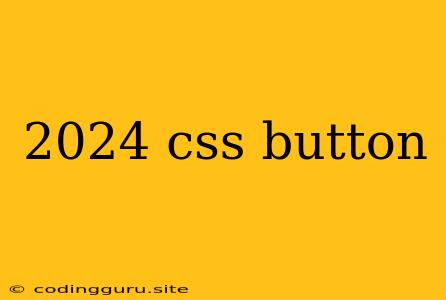Styling Buttons for 2024: Trends and Techniques
As we step into 2024, the world of web design continues to evolve at a rapid pace. One of the most fundamental elements of any website or web application is the humble button. It's the gateway to interaction, the call to action that drives user engagement. So, how do we design buttons that are not only functional but also visually captivating and in line with the latest trends?
The Importance of Buttons
Buttons are more than just clickable elements; they are the visual cues that guide users through their online journey. They tell users what they can do next, whether it's signing up for a newsletter, making a purchase, or exploring further content. A well-designed button can inspire confidence, while a poorly designed one can deter users and lead to frustration.
2024 Button Trends
Here are some key trends in button design that are shaping the web landscape in 2024:
1. Minimalism and Flat Design
Minimalism has been a dominant trend in design for several years, and it's here to stay in 2024. This means clean lines, simple typography, and the absence of unnecessary embellishments. Flat design, with its lack of gradients and shadows, perfectly complements this minimalist aesthetic.
Example: A button with a simple, bold text label in a solid color, placed against a contrasting background.
2. Bold Colors and Vibrant Gradients
While minimalism is on the rise, there's also a growing trend towards bolder, more expressive colors and vibrant gradients. This creates a sense of energy and excitement, particularly effective for calls to action that need to stand out.
Example: A button with a gradient background that transitions from one bright color to another, with contrasting white or black text.
3. Subtle Microinteractions
Microinteractions are small, animated transitions that add a touch of delight to the user experience. For buttons, this could include a slight hover effect, a subtle color shift, or a ripple animation.
Example: A button that changes color slightly on hover, or a subtle pulse animation when clicked.
4. Geometric Shapes and Textures
Incorporating geometric shapes and textures can add visual interest and depth to button design. This can range from simple squares and circles to more complex polygons and patterned backgrounds.
Example: A button with a rounded corner design, or one with a textured background that provides a tactile feel.
5. 3D Elements and Shadows
While flat design is still prevalent, some designers are incorporating subtle 3D elements and shadows to give buttons a more immersive feel. This can be achieved through subtle gradients or the use of box shadows.
Example: A button with a subtle drop shadow, creating the illusion that it's slightly raised from the page.
Tips for Designing Effective Buttons
Here are some tips to keep in mind when designing buttons for 2024:
- Use clear and concise text labels. The button's text should accurately reflect its function.
- Choose colors that contrast with the background. This ensures readability and helps the button stand out.
- Consider the button's size and shape. Make sure the button is large enough to be easily clickable on different screen sizes.
- Use hover states and other microinteractions. These provide visual feedback to the user and enhance usability.
- Test your buttons thoroughly. Ensure they function as expected and provide a positive user experience.
Conclusion
Button design is an essential aspect of creating a successful website or web application. By embracing the latest trends and techniques, designers can create buttons that are both visually appealing and highly functional, enhancing user experience and driving engagement.
Remember, buttons are not just clickable elements, they are the visual cues that guide users through their online journey. By designing buttons that are both aesthetically pleasing and user-friendly, you can create a seamless and enjoyable online experience.
